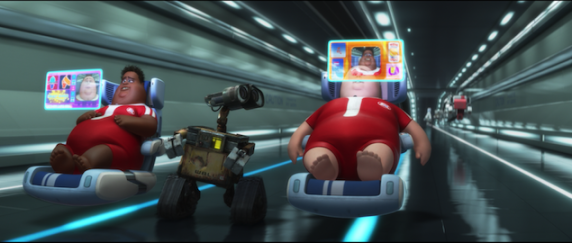Movies of the Past Become Innovations of Tomorrow
Holiday Issue: Innovation of the Mind

Wall-e Pixar’s robot
In the last 100 years, humans have used technology and science to create countless new inventions that many now take for granted. From the zipper, to the aerosol can, to the internet, humanity has grown and learned about itself and the world through these creations.
Each year brings reality closer to the science fiction world that is depicted in many classic books and movies. Back when those stories were created, a future with hoverboards, wireless communication, and holograms seemed far off, if not impossible. One of the most iconic scenes from Star Wars: A New Hope is one where Princess Leia sent the holographic message to Obi Wan Kenobi, saying that he was her “only hope!” In 1977, when the film came out, holographic imaging seemed like a far-fetched invention. However, new developments in technology have now made holograms a feasible idea. Scientists think that in using something called carbon nanotubes, they can potentially create holograms, and they are exploring new possibilities presented by the use of this material.
Despite skepticism, it is impossible to ignore the benefits that have come with the development of long-distance communication. For example, people who live far apart from each other are able to stay in touch. When asked about the effects of the development of holograms as a communication method, an anonymous student responds, “I think holograms would benefit our society, because even though we already have programs such as Skype we don’t really feel as much emotion because it is not 3D. However, the hologram can better give the impression that the person is there.
A common theme in modern films, such as Wall-E, is the idea that increased technology has led to a more independent and isolated society. One disturbing scene from Wall-E shows two friends talking to each other on a video chatting program, much like modern day skype, while sitting right next to each other. The animated fim depicts advancements in technology, specifically the robots they created, as rendering humans unnecessary in most jobs, causing the society to become useless and uncreative.
With the potential to make life easier, the concept of robots has always been a fascinating one in society. Young kids often imagine a robot that does their homework and chores for them, while adults imagine robots that can do dangerous and time consuming work that is unsuitable for humans. When asked what she would use a robot for, Kate Hendrix, librarian, comments, “I would use a robot for the stuff that I yell at my children to get done, like rake the leaves, mow the lawn, etc. Also [robots could be used] to go into dangerous places that we can’t go to. There are definitely situations where a robot would be useful. Like deep sea exploration because they don’t have our limitations.” However, those fantasies are starting to look like a reality with some of the new advancements in robotics.
On the other hand, the stronger and more autonomous robots become, the more humanity needs to take caution so that it doesn’t fall victim to a grim situation of helplessness like the one depicted in Wall-E. When asked her opinion on the advancement of robot technology, Grace Para ’18 comments, “I think we are heading towards that kind of future, because there is so much we don’t have to work for now that is just given to us. We take technology for granted and I think technology can be a beneficial, but not when it is being used for petty purposes. An example of this is when I went to the movie theater and there were seats that recline and have a table. I thought, ‘This is literally Wall-E.’” There has always been some concern about how society uses technology and where the line should be drawn. Another fear is that one day, inventors may create something that can’t be controlled; this theme appears in several movies, from Terminator, to The Matrix, to Age of Ultron. Fortunately, as of now, it is unlikely that there will be any robot apocalypse in the near future.
What society has done, from the creation of the wheel to landing on the moon, has been amazing. Scientists have quite literally reached for the stars, and the next few years will reveal crazy and seemingly impossible new things just as in the last 100 years. With a potential for robots and holograms, the future will be very different from the world today. Society may have to be careful that the dystopias depicted in books and movies do not become a reality, but luckily it seems that today’s innovations will benefit society long before it hinders it.


































